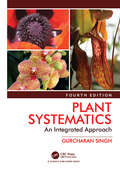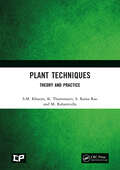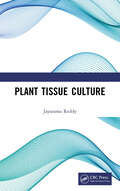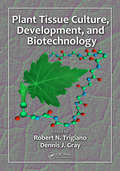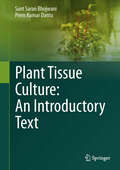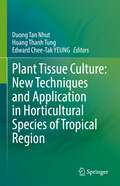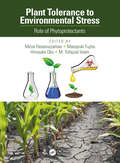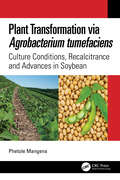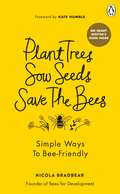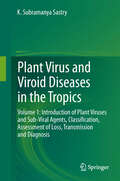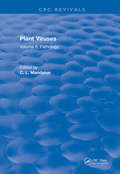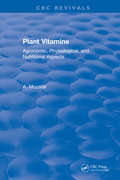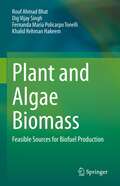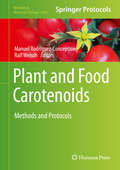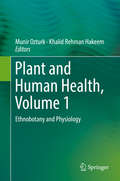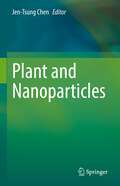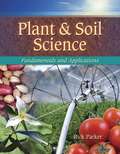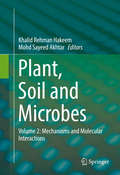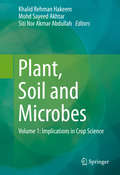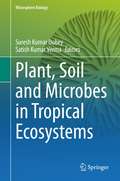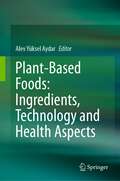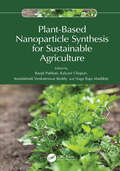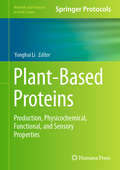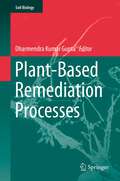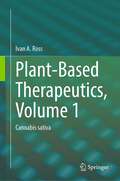- Table View
- List View
Plant Systematics: An Integrated Approach, Fourth Edition
by Gurcharan SinghThis fourth edition of Plant Systematics is completely revised and updated. It incorporates the updated International Code of Nomenclature for Algae, Fungi and Plants (Shenzhen Code, 2018), the new version of PhyloCode (Beta version of Phylocode 5, 2014), APweb version 14 (September, 2018), revised Angiosperm Phylogeny Group classification (APG IV, 2016), new Pteridophyte Phylogeny Group Classification (PPG I, 2016), besides the updates since the publication of third edition. <P><P>The book is a blend of classical fundamental aspects and recent developments, especially in the field of molecular systematics, cladistics and computer identification. Special attention has been given to information on botanical nomenclature, identification, molecular systematics and phylogeny of angiosperms. The complicated concepts of phylogeny, taxometrics and cladistics have been explained with a view to providing a comparison between these diverse but interactive fields of study. An attempt has been made to build upon a common example when exploring different methods, especially in procedures of identification, taxometrics and cladistics. The major systems of classification are evaluated critically. Discussion on major families of Pteridophytes, Gymnosperms and Angiosperms, especially those of major phylogenetic interest, form a major portion of this edition. The ebook includes nearly 500 color photographs set out in 36 pages covering plants from different parts of the world. In addition, 305 black & white illustrations have been included to provide a better understanding of the plants covered in the book.
Plant Techniques: Theory and Practice
by S. Rama Rao S.M. Khasim K. Thammasiri M. RahamtullaThis book deals with the basic concepts of Plant Science including botanical micro technique and microtomy, staining techniques, molecular techniques, plant tissue culture, electron microscopy, and cryopreservation and germplasm storage.It is the outcome of several decades of research and teaching in plant biology to undergraduate and postgraduate students of Plant Science, Horticulture, Microbiology, and Biotechnology.Print edition not for sale in Bangladesh, Bhutan, India, Nepal, Pakistan, and Sri Lanka.
Plant Tissue Culture
by Jayarama ReddyThis book is a comprehensive text on plant tissue culture, with its past, present, and future prospects and techniques discussed in detail. In the first three chapters, the history, terminologies, and applications are given in detail. The fourth chapter is dedicated to the instrumentation of plant tissue culture. The basic techniques used in PTC are described in the sixth chapter. The details of the constituents and types of different nutrient media are discussed in the eighth chapter. In chapter number 9, methods of haploid production have been described. Bioreactors are the instruments that are used for the large-scale production of plantlets and plant products. This book is useful for all the students, researchers, teachers, and industrialists interested in plant tissue culture. Print edition not for sale in india. This book is a comprehensive text on plant tissue culture, with its past, present, and future prospects and techniques discussed in detail.
Plant Tissue Culture, Development, and Biotechnology
by Robert N. Trigiano Dennis J. GrayUnder the vast umbrella of Plant Sciences resides a plethora of highly specialized fields. Botanists, agronomists, horticulturists, geneticists, and physiologists each employ a different approach to the study of plants and each for a different end goal. Yet all will find themselves in the laboratory engaging in what can broadly be termed biotechnol
Plant Tissue Culture: An Introductory Text
by Sant Saran Bhojwani Prem Kumar DantuPlant tissue culture (PTC) is basic to all plant biotechnologies and is an exciting area of basic and applied sciences with considerable scope for further research. PTC is also the best approach to demonstrate the totipotency of plant cells, and to exploit it for numerous practical applications. It offers technologies for crop improvement (Haploid and Triploid production, In Vitro Fertilization, Hybrid Embryo Rescue, Variant Selection), clonal propagation (Micropropagation), virus elimination (Shoot Tip Culture), germplasm conservation, production of industrial phytochemicals, and regeneration of plants from genetically manipulated cells by recombinant DNA technology (Genetic Engineering) or cell fusion (Somatic Hybridization and Cybridization). Considerable work is being done to understand the physiology and genetics of in vitro embryogenesis and organogenesis using model systems, especially Arabidopsis and carrot, which is likely to enhance the efficiency of in vitro regeneration protocols. All these aspects are covered extensively in the present book. Since the first book on Plant Tissue Culture by Prof. P.R. White in 1943, several volumes describing different aspects of PTC have been published. Most of these are compilation of invited articles by different experts or proceedings of conferences. More recently, a number of books describing the Methods and Protocols for one or more techniques of PTC have been published which should serve as useful laboratory manuals. The impetus for writing this book was to make available a complete and up-to-date text covering all basic and applied aspects of PTC for the students and early-career researchers of plant sciences and plant / agricultural biotechnology. The book comprises of nineteen chapters profusely illustrated with self-explanatory illustrations. Most of the chapters include well-tested protocols and relevant media compositions that should be helpful in conducting laboratory experiments. For those interested in further details, Suggested Further Reading is given at the end of each chapter, and a Subject and Plant Index is provided at the end of the book.
Plant Tissue Culture: New Techniques and Application in Horticultural Species of Tropical Region
by Duong Tan Nhut Hoang Thanh Tung Edward Chee-Tak YEUNGThis book presents latest work in the field of plant biotechnology regarding high-efficiency micropropagation for commercial exploitation at low labor and equipment costs. The book consists of 18 chapters on establishing advanced culture systems, techniques as well as latest modification protocols on a variety of crops. It also discusses new methods such as nylon film culture system, light-emitting diode and wireless light-emitting diode system, stem elongation, wounding manipulation and shoot tip removal, in vitro hydroponic and microponic culture system, thin cell layer culture system etc. Plant cell tissue has been developed more than fifty years ago. Since then applications of in vitro plant propagation expanded rapidly all around the world and played as an important role in agricultural and horticultural systems. This book will be of interest to teachers, researchers, scientists, capacity builders and policymakers. Also the book serves as additional reading material for undergraduate and graduate students of agriculture, forestry, ecology, soil science, and environmental sciences.
Plant Tolerance to Environmental Stress: Role of Phytoprotectants
by Masayuki Fujita M. Tofazzal Islam Mirza Hasanuzzaman Hirosuke OkuGlobal climate change affects crop production through altered weather patterns and increased environmental stresses. Such stresses include soil salinity, drought, flooding, metal/metalloid toxicity, pollution, and extreme temperatures. The variability of these environmental conditions pared with the sessile lifestyle of plants contribute to high exposure to these stress factors. Increasing tolerance of crop plants to abiotic stresses is needed to fulfill increased food needs of the population. This book focuses on methods of improving plants tolerance to abiotic stresses. It provides information on how protective agents, including exogenous phytoprotectants, can mitigate abiotic stressors affecting plants. The application of various phytoprotectants has become one of the most effective approaches in enhancing the tolerance of plants to these stresses. Phytoprotectants are discussed in detail including information on osmoprotectants, antioxidants, phytohormones, nitric oxide, polyamines, amino acids, and nutrient elements of plants. Providing a valuable resource of information on phytoprotectants, this book is useful in diverse areas of life sciences including agronomy, plant physiology, cell biology, environmental sciences, and biotechnology.
Plant Transformation via Agrobacterium Tumefaciens: Culture Conditions, Recalcitrance and Advances in Soybean
by Phetole MangenaPlant Transformation via Agrobacterium Tumefaciens compiles fundamental and specific information and procedures involving in vitro soybean transformation, which forms the basis for the Agrobacterium-mediated genetic manipulation of soybean using plant tissue culture. This method serves as one of the most preferred, reliable and cost-effective mechanism of transgene expression in both leguminous recalcitrant species and non-legume crops. The technology is favoured due to its simplicity, feasibility and high transformation rates that are so far achieved mostly in monocot plants and a few dicot genotypes. This book provides a comprehensive review of plant transformation which remains necessary for many researchers who are still facing protocol-related hurdles. Among some of the major topics covered in Plant Transformation via Agrobacterium Tumefaciens are the history and discovery of Agrobacterium bacterium, longstanding challenges causing transformation inefficiencies, types and conditions of explants, development of transgenic plants for stress resistance, and the role of transgenic plants on animal/human health, including the environment. Plant Transformation via Agrobacterium Tumefaciens helps the reader to understand how soybean, like many other orphan legume crops, faces the risk of overexploitation which may render the currently available varieties redundant and extinct should its narrow gene pool not improve. Plant transformation serves as a key technique in improving the gene pool, while developing varieties that are drought tolerant, have enhanced nutritional value, pest resistant and reduce the destruction by disease causing microorganims. This book is an essential foundation tool that is available for researchers and students to reinforce the application of Agrobacterium-mediated genetic transformation in soybean.
Plant Trees, Sow Seeds, Save The Bees: Simple ways to bee-friendly
by Nicola BradbearDiscover the wonder of bees (and other stripey insects) and how to help them survive. In this little book of bees, wasps, hoverflies and more, discover the easy ways to make your gardens, window boxes and pots insect havens. Rewild your garden with plants for bees and honeybees - simple acts of kindness to save the planet. Expert Nicola Bradbear, from Bees for Development charity, shows you how and why it's so important.There are lots of fun things you can do to make a big difference.With every book sold, proceeds will be donated to Bees for Development (www.beesfordevelopment.org)
Plant Virus and Viroid Diseases in the Tropics: Introduction of Plant Viruses and Sub-Viral Agents, Classification, Assessment of Loss, Transmission and Diagnosis
by K. Subramanya SastryPlant virus and sub-viral pathogens pose severe constraints to the production of wide range of economically important crops worldwide. The crops raised both through true seed and vegetative propagated materials are affected with number of virus and virus-like diseases. The virus may enter into plants through seed planting materials or by vectors. Once the virus is in the field, it multiplies and spreads following definite patterns depending upon the nature of the vector and agro-meteorological conditions. Disease free crops and plants are great economic and social importance in feeding the world's population. Detection of virus and sub-viral agents at initial stages of infection is critical to reduce economic losses. For nearly two decades, ELISA and its variants played a major role in large scale virus testing and also in the production of virus-free planting materials.
Plant Viruses: Volume II: Pathology
by C.L. MandaharPlant viruses are of considerable interest to the science of biology, and their study has contributed significantly to the elucidation of several mysteries of traditional and molecular biology.
Plant Vitamins
by A. MozafarThis unique book provides a comprehensive, up-to-date collection of information on the genetic factors, agronomic production methods, and environmental factors that impact the content of vitamins in plants. The effect of various biotic and abiotic stress factors is discussed, and the possible role of some vitamins in plant tolerance to stress factors is also investigated. The book features eye-opening data on vast vitamin variations among farmer-cultivated plants, as well as an extensive comparison between foods grown organically and those grown by conventional methods.With increasing evidence supporting the role of some vitamins in reducing risks of various forms of human cancer, this book provides timely information for researchers, teachers, and students in agronomy, horticulture, plant physiology, food sciences, and human nutrition.
Plant and Algae Biomass: Feasible Sources for Biofuel Production
by Khalid Rehman Hakeem Rouf Ahmad Bhat Dig Vijay Singh Fernanda Maria TonelliThis volume discusses how plant and algae organisms play a pivotal role in the transformation of solar energy to essential metabolites, and explores the numerous beneficial roles these metabolites have at an industrial level. It presents information on the utilization of plant and algae for biomass production, and shows how this is a practical option for large scale biofuel production. The book examines how these bio-metabolites can then be used to extract biofuel. Biomass produced from plants and algae can act as the source of feedstock for biofuel production and industrially important compounds. This book also explores that by curtailing culturing cost using wastewater, seawater, and industrial water as a nutrient and water source, biomass becomes an economical energy source. The introductory chapters of the book focus on the appreciative values of a pollution-free atmosphere, with special reference to enhanced greenhouse effect, and then are followed by chapters on the potential of plant and algae as a liquid energy resource. This book targets researchers, graduate students, and energy and fuel industry professionals interested in the plant sciences, biotechnology and renewable energy.
Plant and Food Carotenoids: Methods and Protocols (Methods in Molecular Biology #2083)
by Manuel Rodríguez-Concepción Ralf WelschThis volume provides a comprehensive compilation of techniques and protocols used in plant and food carotenoid research. Chapters guide readers through seven major areas on core enzyme activities, analysis of carotenoid profiles, new imaging tools, synthesis and degradation dynamics, biotechnology, nutrition, and health. Written in the highly successful Methods in Molecular Biology series format, chapters include introductions to their respective topics, lists of the necessary materials and reagents, step-by-step, readily reproducible laboratory protocols, and tips on troubleshooting and avoiding known pitfalls. Authoritative and cutting-edge, Plant and Food Carotenoids: Methods and Protocols aims to be helpful to researchers of other disciplines that are impacted by carotenoids, including photosynthesis, biotechnology, food science, and nutrition.
Plant and Human Health, Volume 1: Ethnobotany and Physiology
by Khalid Rehman Hakeem Munir OzturkEarly anthropological evidence for plant use as medicine is 60,000 years old as reported from the Neanderthal grave in Iraq. The importance of plants as medicine is further supported by archeological evidence from Asia and the Middle East. Today, around 1.4 billion people in South Asia alone have no access to modern health care, and rely instead on traditional medicine to alleviate various symptoms. On a global basis, approximately 50 to 80 thousand plant species are used either natively or as pharmaceutical derivatives for life-threatening conditions that include diabetes, hypertension and cancers. As the demand for plant-based medicine rises, there is an unmet need to investigate the quality, safety and efficacy of these herbals by the “scientific methods”. Current research on drug discovery from medicinal plants involves a multifaceted approach combining botanical, phytochemical, analytical, and molecular techniques. For instance, high throughput robotic screens have been developed by industry; it is now possible to carry out 50,000 tests per day in the search for compounds, which act on a key enzyme or a subset of receptors. This and other bioassays thus offer hope that one may eventually identify compounds for treating a variety of diseases or conditions. However, drug development from natural products is not without its problems. Frequent challenges encountered include the procurement of raw materials, the selection and implementation of appropriate high-throughput bioassays, and the scaling-up of preparative procedures. Research scientists should therefore arm themselves with the right tools and knowledge in order to harness the vast potentials of plant-based therapeutics. The main objective of Plant and Human Health is to serve as a comprehensive guide for this endeavor. Volume 1 highlights how humans from specific areas or cultures use indigenous plants. Despite technological developments, herbal drugs still occupy a preferential place in a majority of the population in the third world and have slowly taken roots as alternative medicine in the West. The integration of modern science with traditional uses of herbal drugs is important for our understanding of this ethnobotanical relationship. Volume 2 deals with the phytochemical and molecular characterization of herbal medicine. Specifically, it focuess on the secondary metabolic compounds, which afford protection against diseases. Lastly, Volume 3 discusses the physiological mechanisms by which the active ingredients of medicinal plants serve to improve human health. Together this three-volume collection intends to bridge the gap for herbalists, traditional and modern medical practitioners, and students and researchers in botany and horticulture.
Plant and Nanoparticles
by Jen-Tsung ChenThis book explores the interactions between nanomaterials/nanoparticles and plants and unveils potential applications. The chapters emphasize the implications of nanoparticles in cross-discipline approaches, including agricultural science, plant physiology, plant biotechnology, material science, environmental science, food chemistry, biomedical science, etc. It presents recent advances in experimental and theoretical studies and gives in-depth insights into the interaction between nanoparticles and plant cells. In addition, it discusses the potential applications and concerns of nanoparticles comprehensively. The research field of plant nanotechnology has great potential within plant sciences and agriculture and the related research is getting increased at present. The study of plant nanotechnology receives an advantage from the great progress of nanotechnology in biomedical sciences particularly the well-development of a variety of biocompatible nanoparticles (NPs) and advanced analytical techniques. Nowadays, although some NPs have been applied in the studies of plant and agronomic sciences, the knowledge regarding physiology and underlying mechanisms within the plant cell remains limited. This book offers a critical reference for students, teachers, professionals, and a wide array of researchers in plant science, plant physiology, plant biotechnology, material science, environmental science, food chemistry, nanotechnology, and biomedical science. It could also benefit the related field of plant nanotechnology for designing and organizing future research.
Plant and Soil Science: Fundamentals and Applications
by Rick ParkerThis book combines the basic knowledge of plant and soil science, in an easy to read and teach format, and provides practical real world application for information learned. Organized into twenty-eight chapters, each chapter features learning objectives, key terms, tables, charts, illustrations and color photographs to aid the learning and teaching process.
Plant, Soil and Microbes
by Khalid Rehman Hakeem Mohd Sayeed AkhtarThe interactions between the plant, soil, and microbes are very complex in nature and may be antagonistic, mutualistic, or synergistic, depending upon the types of microorganisms and their association with the plant and soil. The multi-trophictactics are involved in these types of interactions to nourish the plants in various habitats and conditions. Understanding the mechanisms of these interactions is highly desired to utilize the knowledge in such an eco-friendly and sustainable way, which may not only resolve the upcoming food security issues but also make the environment green by reducing the chemical inputs. Plant, Soil and Microbes: Mechanisms and Molecular Interactions, along with the recently published Plant, Soil and Microbes: Implications in Crop Science, provide detailed accounts of the exquisite and delicate balance between the three critical components of agronomy. Specifically, these two titles focus on the basis of nutrient exchange between the microorganisms and the host plants, the mechanism of disease protection and the recent molecular details emerged from studying this multitropic interaction. Together they provide a solid foundation for the students, teachers, and researchers interested in soil microbiology, plant pathology, ecology and agronomy.
Plant, Soil and Microbes
by Khalid Rehman Hakeem Mohd Sayeed Akhtar Siti Nor Akmar AbdullahThe interactions between the plant, soil and microbes are complex in nature. Events may be antagonistic, mutualistic or synergistic, depending upon the types of microorganisms and their association with the plant and soil in question. Multi-trophic tactics can therefore be employed to nourish plants in various habitats and growth conditions. Understanding the mechanisms of these interactions is thus highly desired in order to utilize the knowledge in an ecofriendly and sustainable way. This holistic approach to crop improvement may not only resolve the upcoming food security issues, but also make the environment greener by reducing the chemical inputs. Plant, soil and microbe, Volume 1: Implications in Crop Science, along with the forthcoming Volume 2: Mechanisms and Molecular Interactions, provide detailed accounts of the exquisite and delicate balance between the three critical components of agronomy. Specifically, these two titles focus on the basis of nutrient exchange between the microorganisms and the host plants, the mechanism of disease protection and the recent molecular details emerged from studying this multi-tropic interaction. Together they aim to provide a solid foundation for the students, teachers, and researchers interested in soil microbiology, plant pathology, ecology and agronomy.
Plant, Soil and Microbes in Tropical Ecosystems (Rhizosphere Biology)
by Satish Kumar Verma Suresh Kumar DubeyThis book describes the multitude of interactions between plant, soil, and micro-organisms. It emphasizes on how growth and development in plants, starting from seed germination, is heavily influenced by the soil type. It describes the interactions established by plants with soil and inhabitant microbial community. The chapters describe how plants selectively promote certain microorganisms in the rhizospheric ecozone to derive multifarious benefits such as nutrient acquisition and protection from diseases. The diversity of these rhizospheric microbes and their interactions with plants largely depend on plant genotype, soils attributes, and several abiotic and biotic factors. Most of the studies concerned with plant–microbe interaction are focused on temperate regions, even though the tropical ecosystems are more diverse and need more attention. Therefore, it is crucial to understand how soil type and climatic conditions influence the plant–soil–microbes interaction in the tropics. Considering the significance of the subject, the present volume is designed to cover the most relevant aspects of rhizospheric microbial interactions in tropical ecosystems. Chapters include aspects related to the diversity of rhizospheric microbes, as well as modern tools and techniques to assess the rhizospheric microbiomes and their functional roles. The book also covers applications of rhizospheric microbes and evaluation of prospects improving agricultural practice and productivity through the use of microbiome technologies. This book will be extremely interesting to microbiologists, plant biologists, and ecologists.
Plant-Based Foods: Ingredients, Technology and Health Aspects
by Alev Yüksel AydarThe plant-based food industry has flourished in recent years, with a steady stream of exciting product launches reaching the worldwide market. Consumers have become interested in a plant-based diet that includes grains, legumes, seeds, nuts, fruits and vegetables. There are a number of factors involved in this trend, including consumer opposition to harming animals, health problems such as lactose intolerance, desire for a healthier lifestyle and environmental awareness. Several books related to plant-based diets and cookbooks have been published for vegans and vegetarians, however there is no research work related to plant-based production, technology, ingredients and their qualitative and nutritional properties based on the results of scientific studies. Future Food: Plant-Based Products is the first book where the comparison of plant-based products with other alternatives are explored in detail. Novel plant-based product formulations, production and results of recent studies are examined in detail in this book. Plant-based products are mainly alternatives to dairy and meat products, and this text includes comprehensive chapters on meat substitutes and plant-based non-dairy products. In the opening chapter the main ingredients and raw materials used to produce a variety of plant-based products are covered along with their qualitative and nutritional properties. Further chapters focus on the health effects of plant-based products and microbiological and safety issues. For researchers seeking a full, up-to-date overview of plant-based product alternatives and their production, health affects and safety aspects, this book meets your needs.
Plant-Based Nanoparticle Synthesis for Sustainable Agriculture
by Naga Raju Maddela Kondakindi Venkateswar Reddy Ranjit Pabbati Kalyani ChepuriThe use of nanotechnology in agriculture has created many concerns related to toxicity and environmental implications. Green synthesis techniques for producing nanomaterials utilizing plants, microorganisms, and other natural resources have been developed in response to the demand for green chemistry and nanotechnology. This book provides in-depth information on the plant-based synthesis of nanoparticles and how it promotes sustainable agriculture. It critically reviews nanomaterials synthesized from plants and their potential applications, including nanoscale insecticides, herbicides, fungicides, fertilizers, and sensors, which can help to study and manage plant health and soil fertility.The features of this volume include: A comprehensive resource on plant-based nanoparticle synthesis and its usage in gene transformation; Strategies and limitations of plants that are genetically engineered using nanotechnology; Explanation of the design and use of nanofertilizers and nonopesticides for environmental sustainability; Discussions around the toxicity levels of nanoparticles in plants; Aids for professionals and scholars to learn advanced techniques to monitor soil and plant systems using nanotechnology. This is an excellent reference for researchers, academics, students, and professionals in nanotechnology, biochemistry, biomedical sciences, biotechnology, environmental engineering, agricultural sciences, and plant sciences.
Plant-Based Proteins: Production, Physicochemical, Functional, and Sensory Properties (Methods and Protocols in Food Science)
by Yonghui LiThis volumes provides a comprehensive guide to the research and development of plant-based proteins. Chapters coversprotocols and guidelines needed for plant-based protein research and development, from sourcing and processing to the analysis of the physical, chemical, functional, and sensory properties of these proteins. Written in the format of the Methods and Protocols in Food Science series, the chapters include an introduction to the respective topic, list necessary materials and reagents, detail well established and validated methods for readily reproducible laboratory protocols and contain notes on how to avoid or solve typical problems. Authoritative and cutting-edge, Plant-based Proteins: Production, Physicochemical, Functional, and Sensory Properties aims to be a valuable resource for researchers, graduate students, product developers, and food industry professionals working in the field.
Plant-Based Remediation Processes
by Dharmendra Kumar GuptaPhytoremediation is an emerging technology that employs higher plants for the clean-up of contaminated environments. Basic and applied research have unequivocally demonstrated that selected plant species possess the genetic potential to accumulate, degrade, metabolize and immobilize a wide range of contaminants. The main focus of this volume is on the recent advances of technologies using green plants for remediation of various metals and metalloids. Topics include biomonitoring of heavy metal pollution, amendments of higher uptake of toxic metals, transport of heavy metals in plants, and toxicity mechanisms. Further chapters discuss agro-technological methods for minimizing pollution while improving soil quality, transgenic approaches to heavy metal remediation and present protocols for metal remediation via in vitro root cultures.
Plant-Based Therapeutics, Volume 1: Cannabis sativa
by Ivan A. RossBy examining historical applications of the compounds found in plants, this five-volume series serves as a reference for quality assurance, research, product development, and regulatory guidance of the compounds found in plant-based medicines. This work supports the growing consumers' interest in herbal medicine for wellness and health. Plant-Based Therapeutics, Volume 1: Cannabis sativa, the first in the series, covers a unique plant species and provides the framework to integrate its evidence-based scientific discoveries with healthcare therapies. Cannabis has been used in religious ceremonies and medical purposes for thousands of years. Cannabidiol (CBD), the main non-psychoactive component of Cannabis, was isolated in the 1940s, and its structure was established in the 1960s. In 1964 tetrahydrocannabinol (THC), the psychoactive component, was isolated. Cannabis has more than 500 components, of which 104 cannabinoids have been identified. Two of them, THC and CBD, have been the primary components of scientific investigations. They were approved by the FDA for chemotherapy-induced nausea and vomiting in 1985; for appetite stimulation in wasting conditions, such as AIDS, in 1992, and in 2018 for treating two forms of pediatric epilepsy, Dravet syndrome and Lennox-Gastaut syndrome. Beyond the indications for which cannabinoids are FDA-approved, the evidence reveals that cannabinoid receptors are present throughout the body, embedded in cell membranes, and are believed to be more numerous than any other receptor system. When cannabinoid receptors are stimulated, a variety of physiologic processes ensue. Thus, other constituents of Cannabis are extremely promising either as individual compounds or their potential synergistic or entourage effects in the treatment of numerous medical conditions.
